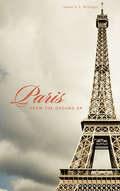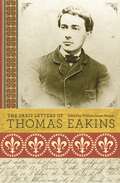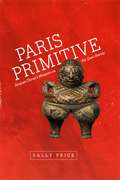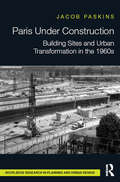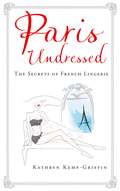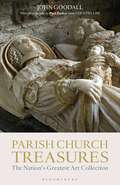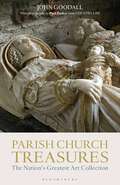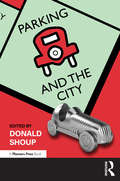- Table View
- List View
Paris from the Ground Up (From The Ground Up Ser. #10)
by James H. McGregorParis is the most personal of cities. There is a Paris for the medievalist, and another for the modernist—a Paris for expatriates, philosophers, artists, romantics, and revolutionaries of every stripe. James H. S. McGregor brings these multiple perspectives into focus throughout this concise, unique history of the City of Light. His panorama begins with an ancient Gallic fortress on the Seine, burned to the ground by its own defenders in a vain effort to starve out Caesar’s legions. After ninth-century raids by the Vikings ended, Parisians expanded the walls of their tiny sanctuary on the Ile de la Cité, turning the river’s right bank into a thriving commercial district and the Rive Gauche into a college town. Gothic spires expressed a taste for architectural novelty, matched only by the palaces and pleasure gardens of successive monarchs whose ingenuity made Paris the epitome of everything French. The fires of Revolution threatened all that had come before, but Baron Haussmann saw opportunity in the wreckage. No planned city in the world is more famous than his. Paris from the Ground Up allows readers to trace the city’s evolution in its architecture and art—from the Roman arena to the Musée d’Orsay, from the Louvre’s defensive foundations to I. M. Pei’s transparent pyramids. Color maps, along with identifying illustrations, make the city accessible to visitors by foot, Metro, or riverboat.
Paris in the Cinema: Beyond the Flâneur
by Alastair Phillips Ginette Vincendeau'Paris in the Cinema' offers a new approach to the representation of Paris on screen. Bringing together a wide range of renowned French and Anglophone specialists in film, television, history, architecture and literature, the volume introduces, challenges and extends ideas about the city as the locus of screen modernity. Through a range of concrete and historically-specific case studies, ranging from particular districts such as Saint-Germain-des-Pres and les banlieues (the suburbs) in French cinema, to iconic figures such as the detective Maigret and the lovers, and from locations such as the hotel, the building site and the Eiffel Tower to filmmakers such as Agnes Varda and Jean-Pierre Jeunet, this unique text demonstrates how the cinematic city of Paris now constitutes a major archive of French cultural history and memory.
Paris in the Cinema: Beyond the Flâneur
by Ginette Vincendeau Alastair PhillipsParis is the most iconic and frequently painted, photographed and filmed city in the world. Paris in the Cinema: Beyond the Flâneur offers a new approach to the representation of Paris on screen. Bringing together a wide range of renowned French and Anglophone specialists in film, history, architecture and literature, Alastair Phillips and Ginette Vincendeau introduce, challenge and extend ideas about the city as the locus of screen modernity. Through a range of concrete and historically-specific case studies, this vibrant collection: • provides innovative angles on how films deploy the French capital beyond its function as glamorous background• explores how filmmakers both construct and recycle its status as an ‘iconic capital’ • considers the specific identities of Parisians on screen• demonstrates how the cinematic city of Paris now constitutes a major archive of French cultural history and memory. Fresh and engaging, this fascinating resource will appeal to all students, scholars and lovers of French cinema and the capital city that comprises its major home.
The Paris Letters of Thomas Eakins
by Thomas EakinsThe young Thomas Eakins's most revealing letters—published here for the first timeThe most revealing and interesting writings of American artist Thomas Eakins are the letters he sent to family and friends while he was a student in Paris between 1866 and 1870. This book presents all these letters in their entirety for the first time; in fact, this is the first edition of Eakins's correspondence from the period. Edited and annotated by Eakins authority William Innes Homer, this book provides a treasure trove of new information, revealing previously hidden facets of Eakins's personality, providing a much richer picture of his artistic development, and casting fresh light on his debated psychosexual makeup. The book is illustrated with the small, gemlike drawings Eakins included in his correspondence, as well as photographs and paintings.In these letters, Eakins speaks openly and frankly about human relationships, male companionship, marriage, and women. In vivid, charming, and sometimes comic detail, he describes his impressions of Paris--from the training he received in the studio of Jean-Léon Gérôme to the museums, concerts, and popular entertainments that captured his imagination. And he discusses with great insight contemporary aesthetic and scientific theories, as well as such unexpected subjects as language structure, musical composition, and ice-skating technique. Also published here for the first time are the letters and notebook Eakins wrote in Spain following his Paris sojourn.This long-overdue volume provides an indispensable portrait of a great American artist as a young man.
A Paris Life, A Baltimore Treasure: The Remarkable Lives of George A. Lucas and His Art Collection
by Stanley MazaroffIn 1857, George A. Lucas, a young Baltimorean who was fluent in French and enamored of French art, arrived in Paris. There, he established an extensive personal network of celebrated artists and art dealers, becoming the quintessential French connection for American collectors. The most remarkable thing about Lucas was not the art that he acquired for his clients (who included William and Henry Walters, the founders of the Walters Art Museum, and John Taylor Johnston, the founding president of the Metropolitan Museum of Art) but the massive collection of 18,000 paintings, drawings, sculptures, and etchings, as well as 1,500 books, journals, and other sources about French artists, that he acquired for himself. Paintings by Cabanel, Corot, and Daubigny, prints by Whistler, Manet, and Cassatt, and portfolios of information about hundreds of French artists filled his apartment and spilled into the adjacent flat of his mistress.Based primarily on Lucas;€™s notes and diaries, as well as thousands of other archival documents, Stanley Mazaroff;€™s A Paris Life, A Baltimore Treasure tells the fascinating story of how Lucas brought together the most celebrated French artists with the most prominent and wealthy American collectors of the time. It also details how, nearing the end of his life, Lucas struggled to find a future home for his collection, eventually giving it to Baltimore;€™s Maryland Institute. Without the means to care for the collection, the Institute loaned it to the Baltimore Museum of Art, where most of the art was placed in storage and disappeared from public view. But in 1990, when the Institute proposed to auction or otherwise sell the collection, it rose from obscurity, reached new glory as an irreplaceable cultural treasure, and became the subject of an epic battle fought in and out of court that captivated public attention and enflamed the passions of art lovers and museum officials across the nation.A Paris Life, A Baltimore Treasure is a richly illustrated portrayal of Lucas's fascinating life as an agent, connoisseur, and collector of French mid-nineteenth-century art. And, as revealed in the book, following Lucas's death, his enormous collection continued to have a vibrant life of its own, presenting new challenges to museum officials in studying, conserving, displaying, and ultimately saving the collection as an important and intrinsic part of the culture of our time.
A Paris Life, A Baltimore Treasure: The Remarkable Lives of George A. Lucas and His Art Collection
by Stanley MazaroffIn 1857, George A. Lucas, a young Baltimorean who was fluent in French and enamored of French art, arrived in Paris. There, he established an extensive personal network of celebrated artists and art dealers, becoming the quintessential French connection for American collectors. The most remarkable thing about Lucas was not the art that he acquired for his clients (who included William and Henry Walters, the founders of the Walters Art Museum, and John Taylor Johnston, the founding president of the Metropolitan Museum of Art) but the massive collection of 18,000 paintings, drawings, sculptures, and etchings, as well as 1,500 books, journals, and other sources about French artists, that he acquired for himself. Paintings by Cabanel, Corot, and Daubigny, prints by Whistler, Manet, and Cassatt, and portfolios of information about hundreds of French artists filled his apartment and spilled into the adjacent flat of his mistress.Based primarily on Lucas;€™s notes and diaries, as well as thousands of other archival documents, Stanley Mazaroff;€™s A Paris Life, A Baltimore Treasure tells the fascinating story of how Lucas brought together the most celebrated French artists with the most prominent and wealthy American collectors of the time. It also details how, nearing the end of his life, Lucas struggled to find a future home for his collection, eventually giving it to Baltimore;€™s Maryland Institute. Without the means to care for the collection, the Institute loaned it to the Baltimore Museum of Art, where most of the art was placed in storage and disappeared from public view. But in 1990, when the Institute proposed to auction or otherwise sell the collection, it rose from obscurity, reached new glory as an irreplaceable cultural treasure, and became the subject of an epic battle fought in and out of court that captivated public attention and enflamed the passions of art lovers and museum officials across the nation.A Paris Life, A Baltimore Treasure is a richly illustrated portrayal of Lucas's fascinating life as an agent, connoisseur, and collector of French mid-nineteenth-century art. And, as revealed in the book, following Lucas's death, his enormous collection continued to have a vibrant life of its own, presenting new challenges to museum officials in studying, conserving, displaying, and ultimately saving the collection as an important and intrinsic part of the culture of our time.
Paris Primitive: Jacques Chirac's Museum on the Quai Branly
by Sally PriceIn 1990 Jacques Chirac, the future president of France and a passionate fan of non-European art, met Jacques Kerchache, a maverick art collector with the lifelong ambition of displaying African sculpture in the holy temple of French culture, the Louvre. Together they began laying plans, and ten years later African fetishes were on view under the same roof as the Mona Lisa. Then, in 2006, amidst a maelstrom of controversy and hype, Chirac presided over the opening of a new museum dedicated to primitive art in the shadow of the Eiffel Tower: the Musée du Quai Branly. Paris Primitive recounts the massive reconfiguration of Paris’s museum world that resulted from Chirac’s dream, set against a backdrop of personal and national politics, intellectual life, and the role of culture in French society. Along with exposing the machinations that led to the MQB’s creation, Sally Price addresses the thorny questions it raises about the legacy of colonialism, the balance between aesthetic judgments and ethnographic context, and the role of institutions of art and culture in an increasingly diverse France. Anyone with a stake in the myriad political, cultural, and anthropological issues raised by the MQB will find Price’s account fascinating.
The Paris Seamstress: Transporting, Twisting, the Most Heartbreaking Novel You'll Read This Year
by Natasha Lester**THE FRENCH PHOTOGRAPHER is now available in ebook**THE INTERNATIONAL BESTSELLER'Fascinating and impeccably researched' GILL PAUL'A fantastically engrossing story. I love it' KELLY RIMMER'A beautiful story in every way' THE LADY'Intrigue, heartbreak... I cannot tell you how much I loved this book' RACHEL BURTONOne of the MOST ANTICIPATED BOOKS OF THE YEAR - Publishers WeeklyCrossing generations, society's boundaries and international turmoil, The Paris Seamstress is a beguiling, transporting story perfect for fans of Lucinda Riley, Kate Furnivall and Penny Vincenzi.********************************************What must Estella sacrifice to make her mark?1940: Parisian seamstress Estella Bissette is forced to flee France as the Germans advance. She is bound for Manhattan with a few francs, one suitcase, her sewing machine and a dream: to have her own atelier.2015: Australian curator Fabienne Bissette journeys to the annual Met Gala for an exhibition of her beloved grandmother's work - one of the world's leading designers of ready-to-wear. But as Fabienne learns more about her grandmother's past, she uncovers a story of tragedy, heartbreak and secrets - and the sacrifices made for love.MORE PRAISE FOR NATASHA LESTER...'If you enjoy historical fiction (and even if you don't) you will love this book' Sally Hepworth'A gorgeously rich and romantic novel' Kate Forsyth'Stunning . . . Will have you captivated' Liz Byrski'This romance will have you enchanted' Woman's Day'Natasha Lester is our generation's Louisa May Alcott' Tess Woods'What a GEM!' Sara Foster'Natasha Lester brings bold, brave women to life' Courier Mail 'I love this book' Rachael Johns'Exquisite!' Vanessa Carnevale'Engaging' Herald Sun'An essential addition to Australian fiction' AusRomToday'Utterly compelling' Good Reading 'Emotion that will touch your heart and soul deeply' Jodi Gibson 'Fascinating, evocative and meticulously researched' Annabel Abbs'Entertaining and provocative' Perth Festival 'Lester has woven a fine, original story of everlasting quality.' BetterReading 'A captivating tale' Daily Examiner 'A delightful and multi-faceted romp through the jazz era' Natalie Salvo'Excellent historical fiction' The Book Muse 'You will love this even if you're not a regular reader of historical fiction' Jess Just Reads 'Storytelling at its finest' Great Reads & Tea Leaves
Paris Sketchbook: Jason Brooks
by Jason BrooksParis Sketchbook is a stunning gift book from leading international fashion illustrator Jason Brooks. Although he is best known for his beautiful fashion imagery, which has regularly graced the pages of Vogue and Elle magazines, travel has been a recurrent theme in his work and his adventures continue to inspire and inform his visual repertoire. During his time on fashion assignments at the couture shows in Paris, Brooks developed a fascination for the city, drawing and painting beautiful travel journals that demonstrate his passion for all things Parisian. This book is a whimsical take on Paris, part guide book, part illustrated journal, it will appeal to both travellers and fashionistas. Sumptuous production with different stocks and inks will make this a must for anyone who loves fashion illustration and beautiful books.
Paris Under Construction: Building Sites and Urban Transformation in the 1960s
by Jacob PaskinsDuring the 1960s, building sites in Paris became spaces that expressed preoccupations about urban transformation, labour immigration and national identity. As new buildings and infrastructure changed the city, building sites revealed the substandard living and working conditions of migrant construction workers in France. Moreover, construction was the touchstone in debates about the dangers of urban life, and triggered action in communities whose districts faced demolition. Paris Under Construction explores the social, political and cultural responses to construction work and urban transformation in the Paris metropolitan region during the 1960s. This examination of a decade of intensive building work considers the ways in which the experience of construction was mediated, produced and reproduced through a range of complex and sometimes contradictory representations. The building sites that produced the new Paris are no longer visible, and were perhaps never intended to be seen, yet different groups closely observed and recorded construction, giving it meanings that went beyond specific building activities. The research draws extensively on French newspaper, television and radio archives, and delves into rarely examined trade union material. Paris Under Construction gives voice to the witnesses of—and participants in—urban transformation who are usually excluded from architectural and urban history.
Paris Under Construction: Building Sites and Urban Transformation in the 1960s
by Jacob PaskinsDuring the 1960s, building sites in Paris became spaces that expressed preoccupations about urban transformation, labour immigration and national identity. As new buildings and infrastructure changed the city, building sites revealed the substandard living and working conditions of migrant construction workers in France. Moreover, construction was the touchstone in debates about the dangers of urban life, and triggered action in communities whose districts faced demolition. Paris Under Construction explores the social, political and cultural responses to construction work and urban transformation in the Paris metropolitan region during the 1960s. This examination of a decade of intensive building work considers the ways in which the experience of construction was mediated, produced and reproduced through a range of complex and sometimes contradictory representations. The building sites that produced the new Paris are no longer visible, and were perhaps never intended to be seen, yet different groups closely observed and recorded construction, giving it meanings that went beyond specific building activities. The research draws extensively on French newspaper, television and radio archives, and delves into rarely examined trade union material. Paris Under Construction gives voice to the witnesses of—and participants in—urban transformation who are usually excluded from architectural and urban history.
Paris Undressed: The Secrets of French Lingerie
by Kathryn Kemp-GriffinFrench women seem inherently more confident in their bodies, able to embrace the sensuality of life and love. What's their secret? Lingerie.Yet, despite an insatiable curiosity for all things French, most women still find lingerie an enigma, a tangled mélange of silk and lace, and are confused about how, when, and where to wear it. (Hint: it's not just for special occasions.) Many aspire to having a drawer full of silky, lacy undergarments, but have no idea where to start: How should my bra fit? How exactly do I wear a garter belt? Do bras and knickers always have to match?With illustrations by French lingerie designer Paloma Casile, Paris Undressed: The Secrets of French Lingerie will help women feel at ease with their figures and show them how to integrate a lingerie lifestyle à la française to enhance their own femininity, confidence, and joie de vivre. It will transform the way women perceive their undergarments - and their bodies - and reveal how to co-ordinate a lingerie wardrobe to reflect personality and to meet lifestyle needs with the right dose of reverie. The book also includes a hand-selected guide to the most confidential addresses and lingerie boutiques in Paris, and discloses where to find the perfect bra, couture camisole or cheeky knicker.Paris Undressed goes behind the seams, combining cultural references, expertise, and practical advice to inspire every woman to reconsider her underwear drawer.
Parish Church Treasures: The Nation's Greatest Art Collection
by Dr John Goodall Paul BarkerOur parish churches constitute a living patrimony without precise European parallel. Their cultural riches are astonishing, not only for their quality and quantity, but also their diversity and interest. Fine art and architecture here combine unpredictably with the functional, the curious and the naïve, from prehistory to the present day, to form an unsung national museum which presents its contents in an everyday setting without curators or formal displays. Because church treasures usually remain in the buildings they were created for, properly interpreted they tell from thousands of local perspectives the history of the nation, its people and their changing religious observance.John Goodall's weekly series in Country Life has celebrated particular objects in or around churches that are of outstanding artistic, social or historical importance, to underline both the intrinsic interest of parish churches and the insights that they and their contents offer into English history of every period. Parish Church Treasures incorporates and significantly expands this material to tell afresh the remarkable history of the parish church. It celebrates the special character of churches as places to visit whilst providing an authoritative and up-to-date history at a time when the use and upkeep of these buildings and the care of their contents is highly contentious.
Parish Church Treasures: The Nation's Greatest Art Collection
by John Goodall Paul BarkerOur parish churches constitute a living patrimony without precise European parallel. Their cultural riches are astonishing, not only for their quality and quantity, but also their diversity and interest. Fine art and architecture here combine unpredictably with the functional, the curious and the naïve, from prehistory to the present day, to form an unsung national museum which presents its contents in an everyday setting without curators or formal displays. Because church treasures usually remain in the buildings they were created for, properly interpreted they tell from thousands of local perspectives the history of the nation, its people and their changing religious observance.John Goodall's weekly series in Country Life has celebrated particular objects in or around churches that are of outstanding artistic, social or historical importance, to underline both the intrinsic interest of parish churches and the insights that they and their contents offer into English history of every period. Parish Church Treasures incorporates and significantly expands this material to tell afresh the remarkable history of the parish church. It celebrates the special character of churches as places to visit whilst providing an authoritative and up-to-date history at a time when the use and upkeep of these buildings and the care of their contents is highly contentious.
The Parisianer: Covers of an Imaginary Magazine
by La Lettre P'Paris is the greatest temple ever built to material joys and the lust of the eyes.' Paris. It has been immortalised a thousand times over in the pages of books, on timeless canvases and in countless songs. For centuries the city's undeniable magic and certain je ne sais quoi have been objects of fascination, dictating our cultural and culinary tastes. It has been home to and a perennial source of inspiration for some of the world's greatest thinkers, writers, artists and designers - so how do you capture the essence of such an enchanting city? In this stunning collection of imagined covers, a tribute to the famous cover art of the New Yorker, over one hundred French illustrators pay homage to the remarkable City of Lights that for centuries has captured our collective imaginations. Each exquisitely realised cover celebrates a different aspect of Paris, featuring subjects as diverse as protesters, Japanese tourists, pigeons and beautiful women. The Parisianer is a must-have for every admirer of this most romantic and unforgettable city, and for anyone who wants to fall in love with it all over again.
The Park Avenue Cubists: Gallatin, Morris, Frelinghuysen and Shaw
by Robert S. LubarThis title was first published in 2002. The Park Avenue Cubists explores the work of a group of American artists committed to the belief that American abstraction could make a unique contribution to the evolution of the visual experiments begun by the European Modernists. All were inspired by the work of Braque, Picasso, Gris and Leger which they witnessed at first hand during repeated trips to Paris. Dubbed the 'Park Avenue Cubists' for the wealth and social status that enabled them to promote their own work and patronise that of their fellow members of the American Abstract Artists (AAA), the group included Albert Eugene Gallatin, George L.K. Morris, Suzy Frelinghuysen and Charles G. Shaw. Featuring essays by Debra Bricker Balken and Robert S. Lubar on the group's place in the history of modern art, along with individual studies of the four artists and an appendix bringing together the key statements written by the artists themselves, this volume provides the first in-depth study of the group.
The Park Avenue Cubists: Gallatin, Morris, Frelinghuysen and Shaw
by Robert S. LubarThis title was first published in 2002. The Park Avenue Cubists explores the work of a group of American artists committed to the belief that American abstraction could make a unique contribution to the evolution of the visual experiments begun by the European Modernists. All were inspired by the work of Braque, Picasso, Gris and Leger which they witnessed at first hand during repeated trips to Paris. Dubbed the 'Park Avenue Cubists' for the wealth and social status that enabled them to promote their own work and patronise that of their fellow members of the American Abstract Artists (AAA), the group included Albert Eugene Gallatin, George L.K. Morris, Suzy Frelinghuysen and Charles G. Shaw. Featuring essays by Debra Bricker Balken and Robert S. Lubar on the group's place in the history of modern art, along with individual studies of the four artists and an appendix bringing together the key statements written by the artists themselves, this volume provides the first in-depth study of the group.
Parker, Lopez and Stone's The Book of Mormon (The Fourth Wall)
by Brian Granger'Hasa Diga Eebowai' In 2011, a musical full of curse words and Mormon missionaries swept that year’s Tony Awards and was praised as a triumphant return of the American musical. This book explores the inherent achievements (and failures) of The Book of Mormon—one of the most ambitious, and problematic, musicals to achieve widespread success. The creative team members—Matt Parker, Trey Stone and composer Robert Lopez—were collectively known for their aggressive use of taboo subjects and crude, punchy humor. Using the metaphor of boxing, Granger explores the metaphorical punches the trio delivers and ruminates over the less-discussed ideological wounds that their style of shock absurdism might leave behind. This careful examination of where The Book of Mormon succeeds and fails is sure to challenge discussion of our understanding of musical comedy and our appreciation for this cultural landmark in theatre.
Parkhäuser - Garagen: Grundlagen, Planung, Betrieb (Baukonstruktionen #18)
by Anton Pech Günther Warmuth Klaus Jens Johannes ZeiningerDer Sonderband der Fachbuchserie Baukonstruktionen ist der Parkhausplanung gewidmet. Ausgehend von der Problematik des ruhenden Verkehrs, den Planungsgrundlagen des Entwurfs sowie des Betriebs werden alle Bereiche eines funktionsgerechten und wirtschaftlichen Parkhauses behandelt. In einfachen Beispielen, zahlreichen Plänen, Skizzen und Bildern werden die komplexen Zusammenhänge einer Parkhauserrichtung bzw. des Parkhausbetriebes behandelt. Für die tägliche Planungsarbeit stehen im Buch unterschiedliche Schablonen für Parkanordnungen zur Verfügung. Auch die gesetzlichen Rahmenbedingungen werden berücksichtigt.Die zweite Auflage wurde korrigiert und aktualisiert.
Parkhäuser - Garagen: Grundlagen, Planung, Betrieb (Baukonstruktionen #18)
by Anton Pech Günther Warmuth Klaus Jens Johannes ZeiningerDer Sonderband der Fachbuchserie Baukonstruktionen ist der Parkhausplanung gewidmet. Ausgehend von der Problematik des ruhenden Verkehrs, den Planungsgrundlagen des Entwurfs sowie des Betriebs werden alle Bereiche eines funktionsgerechten und wirtschaftlichen Parkhauses behandelt. In einfachen Beispielen, zahlreichen Plänen, Skizzen und Bildern werden die komplexen Zusammenhänge einer Parkhauserrichtung bzw. des Parkhausbetriebes behandelt. Für die tägliche Planungsarbeit stehen im Buch unterschiedliche Schablonen für Parkanordnungen zur Verfügung. Auch die gesetzlichen Rahmenbedingungen werden berücksichtigt.
Parking and the City
by Donald ShoupDonald Shoup brilliantly overcame the challenge of writing about parking without being boring in his iconoclastic 800-page book The High Cost of Free Parking. Easy to read and often entertaining, the book showed that city parking policies subsidize cars, encourage sprawl, degrade urban design, prohibit walkability, damage the economy, raise housing costs, and penalize people who cannot afford or choose not to own a car. Using careful analysis and creative thinking, Shoup recommended three parking reforms: (1) remove off-street parking requirements, (2) charge the right prices for on-street parking, and (3) spend the meter revenue to improve public services on the metered streets. Parking and the City reports on the progress that cities have made in adopting these three reforms. The successful outcomes provide convincing evidence that Shoup’s policy proposals are not theoretical and idealistic but instead are practical and realistic. The good news about our decades of bad planning for parking is that the damage we have done will be far cheaper to repair than to ignore. The 51 chapters by 46 authors in Parking and the City show how reforming our misguided and wrongheaded parking policies can do a world of good. Read more about parking benefit districts with a free download of Chapter 51 by copying the link below into your browser. https://www.routledge.com/posts/13972
Parking and the City
by Donald ShoupDonald Shoup brilliantly overcame the challenge of writing about parking without being boring in his iconoclastic 800-page book The High Cost of Free Parking. Easy to read and often entertaining, the book showed that city parking policies subsidize cars, encourage sprawl, degrade urban design, prohibit walkability, damage the economy, raise housing costs, and penalize people who cannot afford or choose not to own a car. Using careful analysis and creative thinking, Shoup recommended three parking reforms: (1) remove off-street parking requirements, (2) charge the right prices for on-street parking, and (3) spend the meter revenue to improve public services on the metered streets. Parking and the City reports on the progress that cities have made in adopting these three reforms. The successful outcomes provide convincing evidence that Shoup’s policy proposals are not theoretical and idealistic but instead are practical and realistic. The good news about our decades of bad planning for parking is that the damage we have done will be far cheaper to repair than to ignore. The 51 chapters by 46 authors in Parking and the City show how reforming our misguided and wrongheaded parking policies can do a world of good. Read more about parking benefit districts with a free download of Chapter 51 by copying the link below into your browser. https://www.routledge.com/posts/13972
Parking Management Best Practices
by Todd LitmanThis book is a blueprint for developing an integrated parking plan. It explains how to determine parking supply and affect parking demand, as well as how to calculate parking facility costs. It also offers information about shared parking, parking maximums, financial incentives, tax reform, pricing methods, and other management techniques. What types of locations benefit from parking management? Places with perceived parking problems. Areas with rapidly expanding population, business activity, or traffic. Commercial districts and other places with compact land-use patterns. Urban areas in need of redevelopment and infill. Places with high levels of walking or public transit or places that want to encourage those modes. Districts where parking problems hinder economic development. Areas with high land values Neighborhoods concerned with equity, including fairness to nondrivers. Places with environmental concerns. Unique landscapes or historic districts in need of preservation,"
Parking Management Best Practices
by Todd LitmanThis book is a blueprint for developing an integrated parking plan. It explains how to determine parking supply and affect parking demand, as well as how to calculate parking facility costs. It also offers information about shared parking, parking maximums, financial incentives, tax reform, pricing methods, and other management techniques. What types of locations benefit from parking management? Places with perceived parking problems. Areas with rapidly expanding population, business activity, or traffic. Commercial districts and other places with compact land-use patterns. Urban areas in need of redevelopment and infill. Places with high levels of walking or public transit or places that want to encourage those modes. Districts where parking problems hinder economic development. Areas with high land values Neighborhoods concerned with equity, including fairness to nondrivers. Places with environmental concerns. Unique landscapes or historic districts in need of preservation,"
